Soccer newsletter: MLS and World Cup have symbiotic relationship
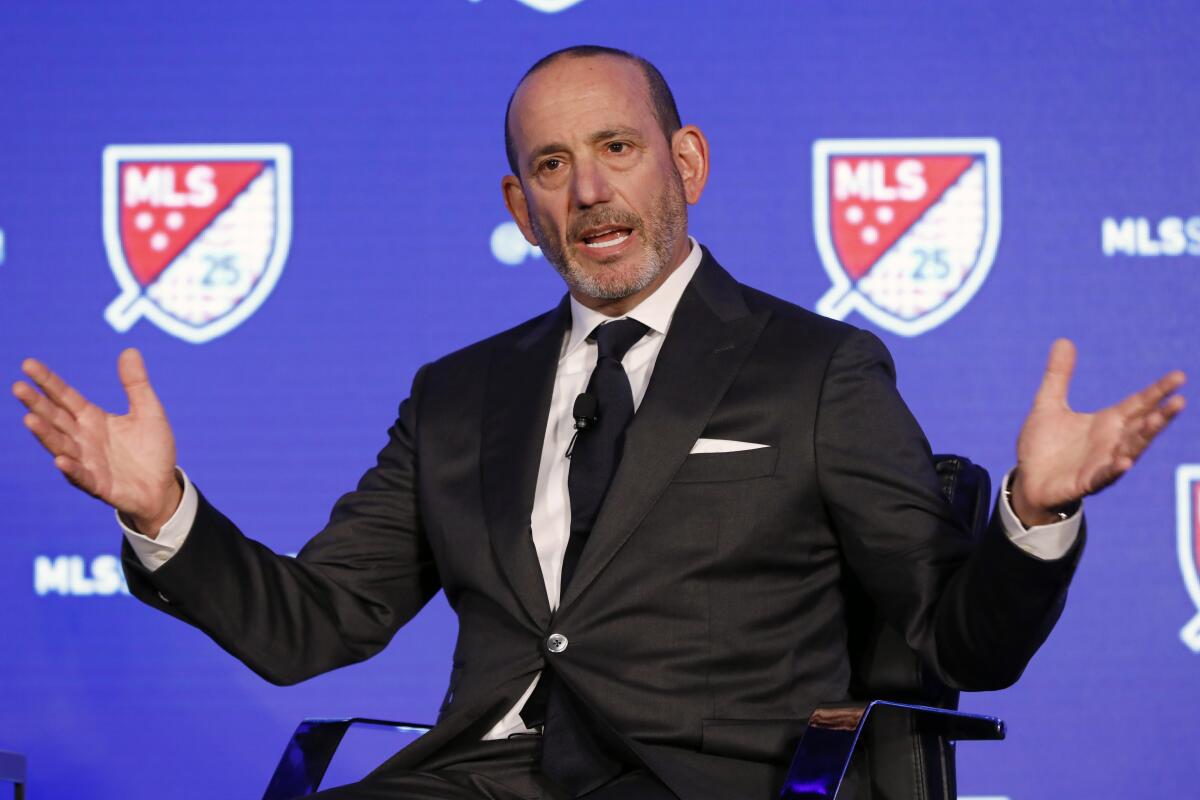
Hello and welcome to the weekly L.A. Times soccer newsletter. I’m Kevin Baxter, The Times’ soccer writer. Today we’ll look at the tough road again for LAFC; ponder where the Galaxy would be without Dejan Jovelic; acknowledge where Angel City is without Christen Press; and reveal the record transfer fee Orange County received to send Kobi Henry from Orange County to northeastern France.
But we start with what was a very good week for MLS and soccer in the U.S.
On Tuesday the league announced its long-awaited broadcast agreement and it proved to be one worth waiting for: a 10-year deal with Apple TV that will pay MLS a minimum of $2.5 billion, with a potential to make a lot more through a percentage of subscriptions sales, according to a source with knowledge of the deal.
That’s not exactly English Premier League money, but it’s more than 2 ½ times the value of the league’s current deal.
Two days later, FIFA released the list of sites for the 2026 World Cup. All 13 U.S. and Canadian cities selected are in league markets and five of the stadiums chosen are MLS venues. That’s quite an accomplishment for a league that didn’t even exist the last time the World Cup was in North America.
Enjoying this newsletter? Consider subscribing to the Los Angeles Times
Your support helps us deliver the news that matters most. Become a subscriber.
“The development of professional soccer in our country is nothing short of remarkable,” commissioner Don Garber said.
Consider the trajectory. There were no pro soccer teams to welcome the World Cup to the U.S. 28 years ago; in fact, FIFA conditioned the awarding of the 1994 tournament to the U.S. on the country creating a first-division league. That World Cup went on to set still-standing records for overall and average attendance. MLS, its progeny, kicked off two years later.
By the time the World Cup returns in 2026, MLS will have at least 30 teams playing in two countries, 18 states and the District of Columbia.
MLS attendance this season was averaging 20,299 per game entering last weekend, trailing only the EPL, Liga MX, La Liga, Bundesliga and France’s Ligue 1 while ranking ahead of Italy’s Serie A. Most of those leagues had more than a half-century head start on the American competition.
Most important, however, is the fact MLS introduced the sport to cities such as Atlanta, Kansas City, Toronto and Vancouver, all of whom have been picked to host World Cup games.
“Atlanta,” Mayor Andre Dickens said, “is a soccer town.”
Who ever thought Atlanta’s mayor would say that? But who can argue?
Since it joined MLS six years ago, Atlanta United has won an MLS Cup and broken every top-10 attendance record for stand-alone MLS games. The team’s average attendance of 45,776 this season is 12th in the world, ahead of Paris St-Germain, Real Madrid, Everton and Bayern Munich.
In four years, United’s stadium will play host to the World Cup.
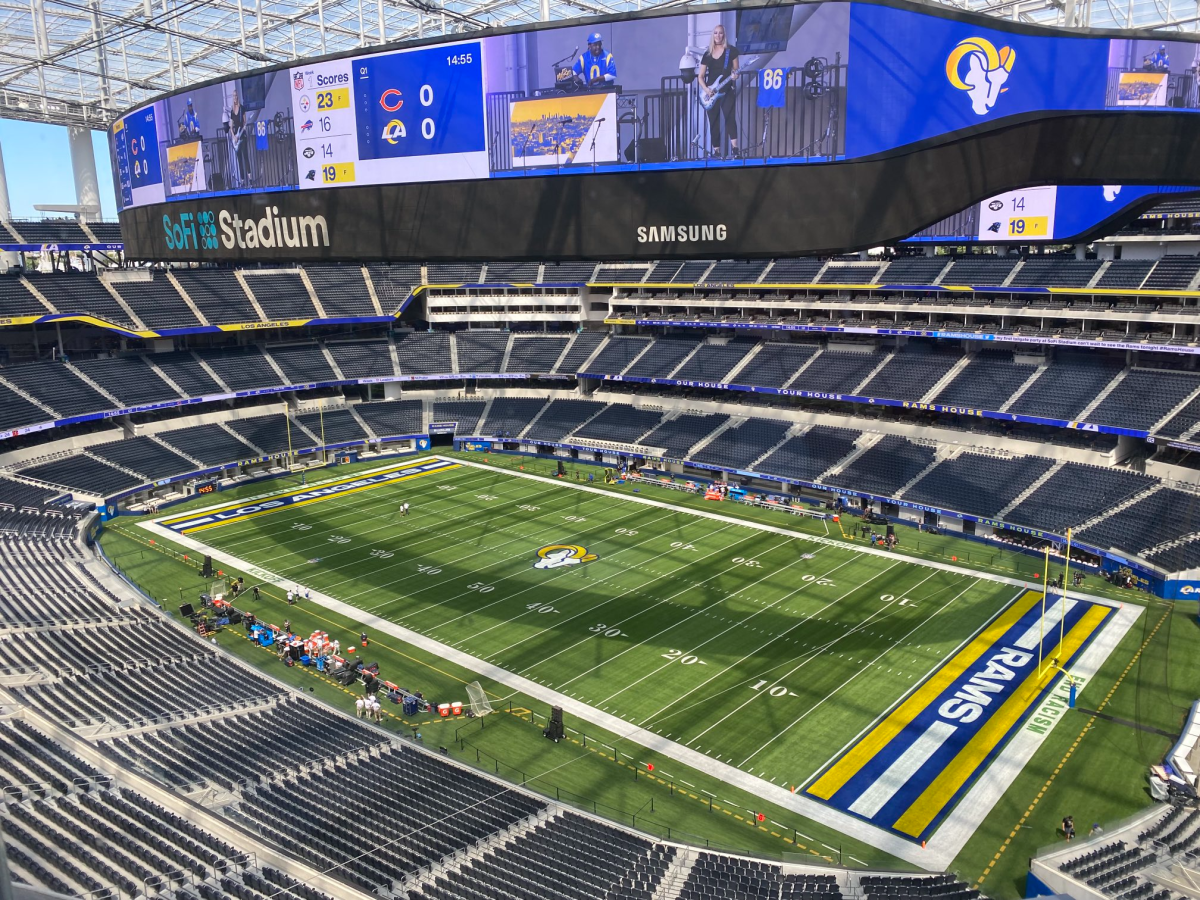
Here’s another way the country’s soccer culture and infrastructure have changed: Of the nine markets to stage games in the 1994 tournament, only four were given games this time around. Even the Rose Bowl in Pasadena, site of eight games including the final in 1994, didn’t make the cut. It was replaced by Inglewood’s SoFi Stadium, which interestingly is within 11 miles of Southern California’s two MLS venues, Dignity Health Sports Park and Banc of California Stadium.
“It’s a soccer city,” Galaxy president Chris Klein, co-chair of the Los Angeles World Cup host committee, said last Thursday, repeating a phrase many cities used in the wake of venue announcements. “We couldn’t be more excited to showcase our city and certainly the soccer culture that we have here.”
The unprecedented growth of the soccer culture and infrastructure in the U.S. not only includes teams, stadiums and fan bases but training grounds as well. Southern California has world-class facilities at Dignity Health Sports Park, UCLA and at LAFC’s headquarters on the campus of Cal State L.A. Atlanta United, the New England Revolution, Inter Miami, New York City FC, Sporting Kansas City and the Vancouver Whitecaps, who all play in 2026 World Cup markets, have opened similarly impressive training grounds since 2017.
“There’s some great sites as base camps or training sites here in L.A.,” said LAFC co-president Larry Freedman, who also is a chair of the World Cup host committee. “We went into this looking for a bunch of games and are hopeful that as actual schedules start getting made, that L.A. [gets] four, six matches.”
Those decisions probably won’t be made for some time. But what already is certain is the 2026 World Cup will be the largest and most complex in history, with a record 48 teams playing 80 games in the U.S., Canada and Mexico, marking the first time the tournament has been shared by three countries. Given the 16 additional games, the overall World Cup attendance record is certain to fall. And since every game will be played in an existing stadium — compare that to Qatar, Russia and Brazil, where the 32 stadiums used in those three World Cups were either built or heavily renovated for the tournament —the 2026 World Cup likely will be the most profitable in history as well.
None of that happens without the success of MLS. The first U.S. World Cup gave birth to MLS and the league’s success led to the second U.S. World Cup, and the same kind of cause-and-effect relationship exists between MLS and its new TV deal.
MLS’ last rights agreement, signed in 2014 with FOX Sports, ESPN, Univision and Canadian broadcasters TSN and TVA, paid the league approximately $105 million a season. In negotiating the new deal, the league leveraged the once-in-a-generation opportunity to be involved in North American soccer in the run-up to the World Cup’s return.
Last week’s agreement does that and more.
As part of the deal, Apple is creating a subscription service to present the matches and related content, such as highlight shows, replays and whip-arounds to live action throughout the league. And because the games will be carried on a streaming service, they’ll be available anywhere in the world.
They’re also meeting viewers where they are, since 83% of MLS fans watch sports on streaming devices or recorded TV in a typical week.
“Obviously, this will be an economic benefit to our teams,” Garber said. “As our team values continue to rise and as the energy and momentum around the league continues to grow, our investments have grown, and you all see that. You’re seeing this with investment in facilities. You’re seeing it with investment in our player pool and the strategic investment of bringing in the kind of players that could make our clubs more competitive.
“It’s been a massive investment. We’ve got to generate revenue in how we’re monetizing our content. This deal is an example.”
It just might be the deal that saves the league too.
According to Garber, MLS lost close to $1 billion in revenue in 2020 and nearly as much in 2021. Much of the blame for that was pinned on COVID-19, which forced teams to fly charters and play in empty stadiums, but Forbes said the league lost $700 million in 2018, two years before anyone had heard of the coronavirus.
In 26 seasons, MLS has never turned a profit.
The new TV deal, which takes effect next season, won’t close that gap. But it can shrink it considerably, and for that Garber can thank not only Apple but also the World Cup, the tournament that brought the league into being, then returned in time to save it.
2026 World Cup host stadiums
United States
AT&T Stadium (Arlington, Texas): A favorite home away from home for the Mexican national team, the Dallas Cowboys’ stadium is the largest venue in the NFL with 93,000 seats. Opened in 2009, it has a retractable roof and an artificial surface.
Mercedes-Benz Stadium (Atlanta): One of three NFL-MLS venues, the five-year-old stadium has a retractable roof and an artificial surface and seats about 75,000.
MetLife Stadium (East Rutherford, N.J.): The 12-year-old stadium, home to the New York Jets and New York Giants, is the heavy favorite to land the World Cup final given its more-favorable time difference with Europe in comparison to other contenders such as SoFi and AT&T. It has a seating capacity of about 87,000 and has an artificial surface.
Gillette Stadium (Foxborough, Mass.): Suburban Foxborough played host to games at the 1994 World Cup, but Gillette Stadium is a different venue. Opened in 2002, it has a seating capacity of about 70,000.
NRG Stadium (Houston): Opened in 2002, NRG has a seating capacity of about 72,000 and an artificial surface. Its retractable roof and air conditioning will be important given the area’s summer heat and humidity.
Arrowhead Stadium (Kansas City, Mo.): The second-oldest stadium on the list, Arrowhead opened in 1972 and has been renovated several times, most recently in 2010. The seating capacity is about 76,000 and it has a grass surface.
Hard Rock Stadium (Miami Gardens, Fla.): Miami appears to be a cinch to get at least one game. The venue, which has a seating capacity of about 67,000, a grass surface and a roof that covers spectators, opened in 1987 and has been renovated multiple times.
Lincoln Financial Field (Philadelphia): When the facility opened in 2003, its first event was a soccer match between Manchester United and Barcelona. The stadium serves as the home venue for the Philadelphia Eagles and Temple University. The 2015 CONCACAF Gold Cup final was played at the stadium, which seats nearly 70,000 and has a natural grass surface.
Levi’s Stadium (Santa Clara): Opened in 2014, the stadium has played host to a Super Bowl and several major soccer games. It has a capacity of about 71,000 and a grass surface.
Lumen Field (Seattle): Home to the NFL’s Seattle Seahawks, the OL Reign of NWSL and the Sounders of MLS, the stadium opened in 2002 and has a capacity of about 69,000 and artificial turf.
SoFi Stadium (Inglewood): Newest of the World Cup venues, SoFi, the most expensive stadium on the planet, opened in 2020. It has a seating capacity of about 70,000, an artificial surface and a fixed roof as well as a narrow field that will be expanded through the removal of demountable seats in the lower bowl.
Canada
BMO Field (Toronto): Home of the Toronto Argonauts of the CFL and Toronto FC of MLS, it originally was constructed as a soccer venue. It has a hybrid surface and a capacity that can expand to about 45,000.
BC Place (Vancouver): Opened in 1983, BC Place has served as the home of the BC Lions of the CFL since its inauguration. The stadium also hosts home games for the Vancouver Whitecaps of the MLS. The stadium has a capacity of about 54,000 and artificial turf. It was last renovated in 2011.
Mexico
Estadio Akron (Guadalajara): Opened in 2010, the stadium has hosted a Copa Libertadores final and the opening ceremony of the 2011 Pan American Games. Chivas plays its home matches at the venue, which has a capacity of about 48,000 and a grass surface.
Estadio Azteca (Mexico City): One of the most iconic stadiums in soccer, it played host to World Cup finals in 1970 and 1986 as well as the 1986 quarterfinal between Argentina and England when Diego Maradona scored two of the most memorable goals in history. Opened in 1966 and reconfigured several times since, it has a capacity of about 87,000 with a grass surface. It’s also more than a mile and a third above sea level.
Estadio BBVA (Monterrey): Opened in 2015, it has a grass surface and seating for about 53,000. Monterrey plays its home matches at the stadium.
Tough tests ahead for LAFC; where would Galaxy be without Joveljic?
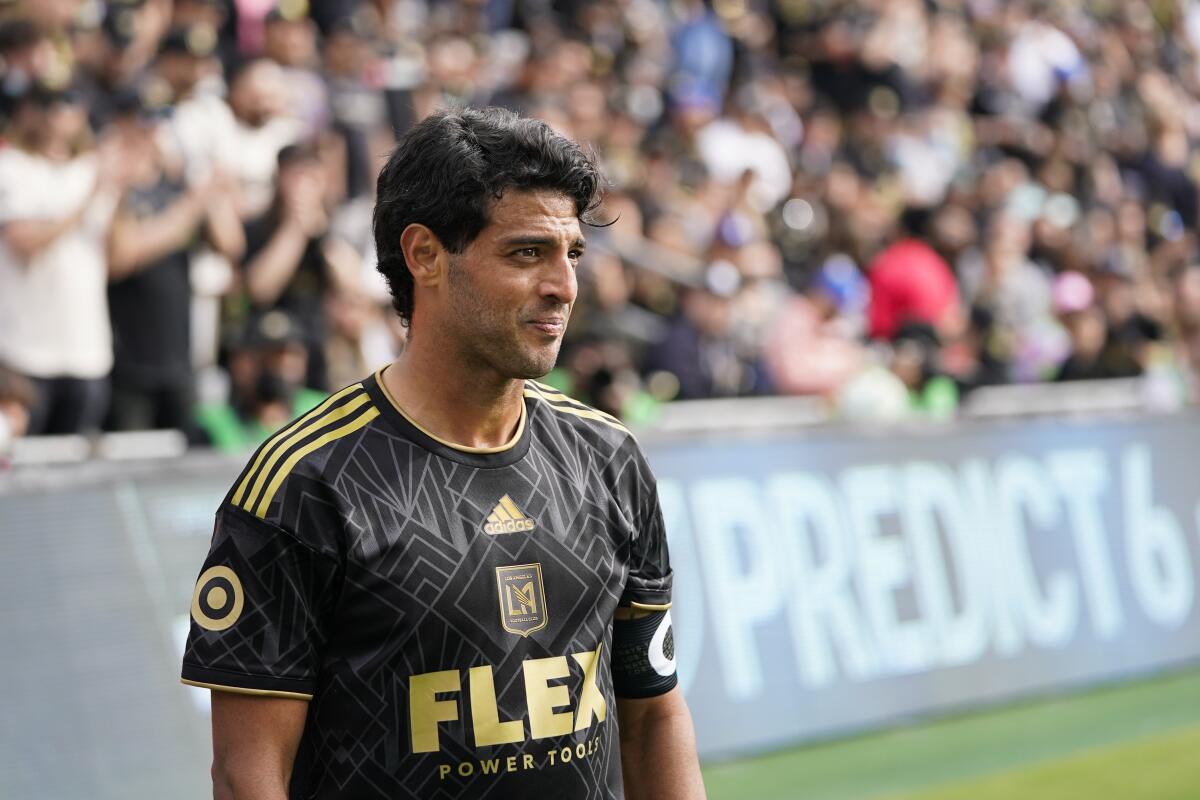
Speaking of MLS, LAFC and the Galaxy looked anything but sharp coming out of the league’s three-week international break, with both teams needing second-half rallies to avoid defeat Saturday.
LAFC escaped Seattle with a point on Cristian Arango’s header in the 79th minute, a result that left the black and gold with a two-point lead atop the Supporters’ Shield standings. But there could be trouble ahead.
Only one of LAFC’s league-high nine wins has come against a team that currently has a winning record. That was a road win against Orlando in April. LAFC (9-3-3) has played three other teams in the top 10 of the league standings: Philadelphia, Austin and the Galaxy, and has gone 0-2-1. That’s significant since LAFC is entering the toughest stretch of its schedule, with five of its next seven games coming against winning teams.
And it could be playing most of those games without its captain.
Carlos Vela, the 2019 league most valuable player and the single-season scoring leader, will have his contract expire at the end of the month. A new deal has been finalized and is waiting only for Vela’s signature, but that may not be coming.
“For the moment there’s nothing signed,” Vela said in Spanish after his 100th MLS appearance Saturday. “We’re still in the same situation.
“In the end this is a business. I’m open to be here, but if it’s not working and this thing is not happening, I’m also open to be in another place.”
Vela was the best-paid player in the league at $6.5 million last year but he took a prorated pay cut of more than a third for the first half of this season. Terms of the extension, reported to be for 18 months, have not been released but the team appears to be done negotiating with a player who has started just 31 of 71 games over the last three seasons and scored only 15 times.
If Vela does not re-sign, LAFC would have two designated-player spots available entering the summer transfer window, which opens next month.
Seattle was gifted its only goal Saturday when Albert Rusnák took advantage of an apparent miscommunication between LAFC goalkeeper Maxime Crepeau and midfielder Ilie Sánchez to give the Sounders a 1-0 lead in the 58th minute. Arango’s late header, his second goal in as many games and his fourth of the season, matched that.
The Galaxy also needed a late goal to earn a point, with Dejan Joveljic coming off the bench to score in the 88th minute in a 1-1 draw with Portland. Few players have been more productive than Joveljic, who has four goals and two assists in 284 MLS minutes this season. His score Saturday was his fourth in his last three games in all competitions and tied him with captain Javier “Chicharito” Hernández for the team lead with seven.
But the Galaxy (7-5-2) have won just one of their last five games in MLS play and they too have entered a difficult stretch of five games in 21 days.
“The frustration, for me, is just that, on the day, a lot of things were disconnected and weren’t clear,” said Galaxy coach Greg Vanney who, presumably, is responsible for providing that missing clarity. “It just wasn’t a sharp performance from everywhere, pretty much, on the field.”
Portland’s goal came from Yimmi Chara on a breakaway in the 38th minute. The Galaxy have allowed multiple goals just twice in their last 15 games in all competitions; only three teams have conceded fewer in MLS this season.
Angel City pressing without Press
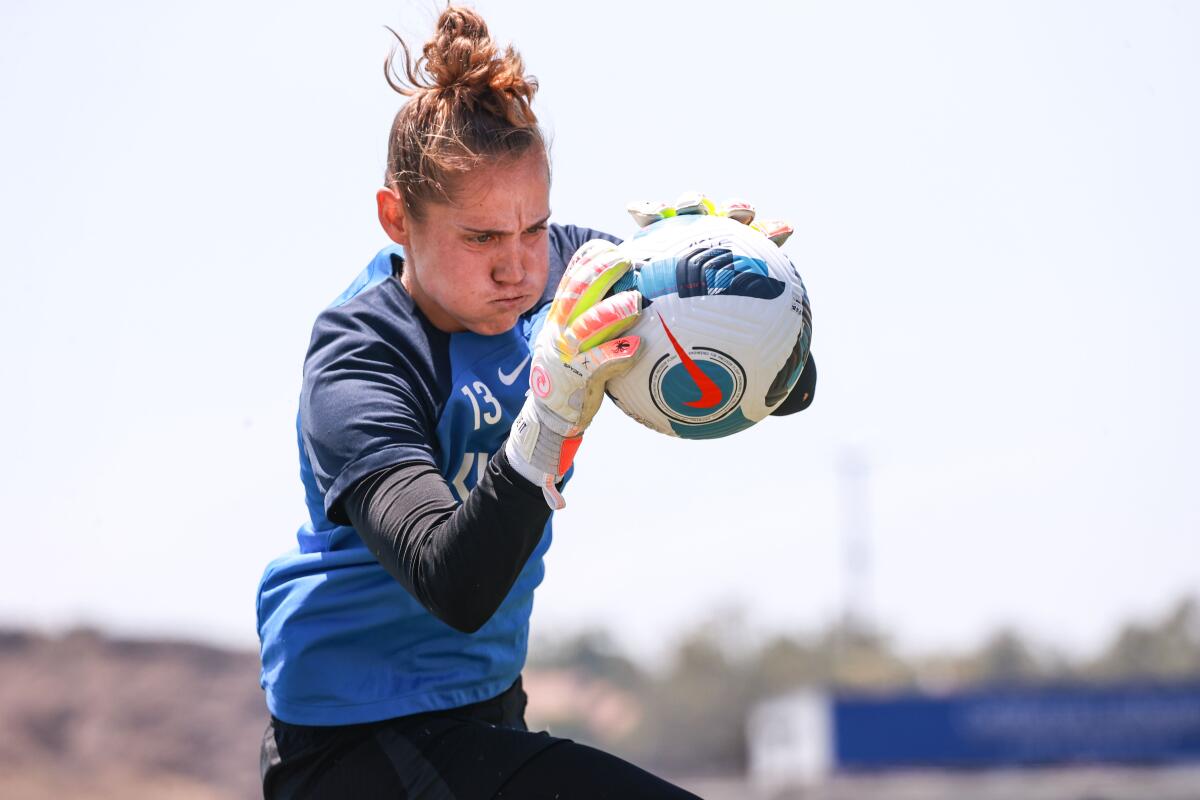
Angel City has struggled to score under the best of circumstances this season, so it stood to reason things wouldn’t get much better Saturday in Seattle in its first game without Christen Press, the team’s leader on offense.
Press tore the anterior cruciate ligament in her right knee in the second half of the team’s win over Racing Louisville earlier this month, a match in which she had a goal and an assist. She will miss the rest of the season, maybe more. And the hole she left in Angel City’s attack only got bigger in the 32nd minute in Seattle when forward Simone Charley came off with an injury.
Without them, Angel City (4-4-1) was blanked for the fourth time in five matches in a 1-0 loss to the OL Reign as the team took a season-low six shots.
Bethany Balcer scored the only goal the Reign needed in the 31st minute.
“We didn’t show up fully today,” goalkeeper DiDi Haracic said. “We’re disappointed. We know how good we are. Teams should be scared of us.
“We don’t like losing.”
The physical match was notable for one other incident — Megan Rapinoe’s expulsion in the 72nd minute after picking up her second red card for dissent. The red card was the first for the OL Reign forward in 176 games with six teams in four leagues in a pro career that began in 2009. She’s never been ejected in 187 USWNT matches.
Angel City won’t play again until July 1.
O Henry! OCSC gets record transfer fee for teen defender
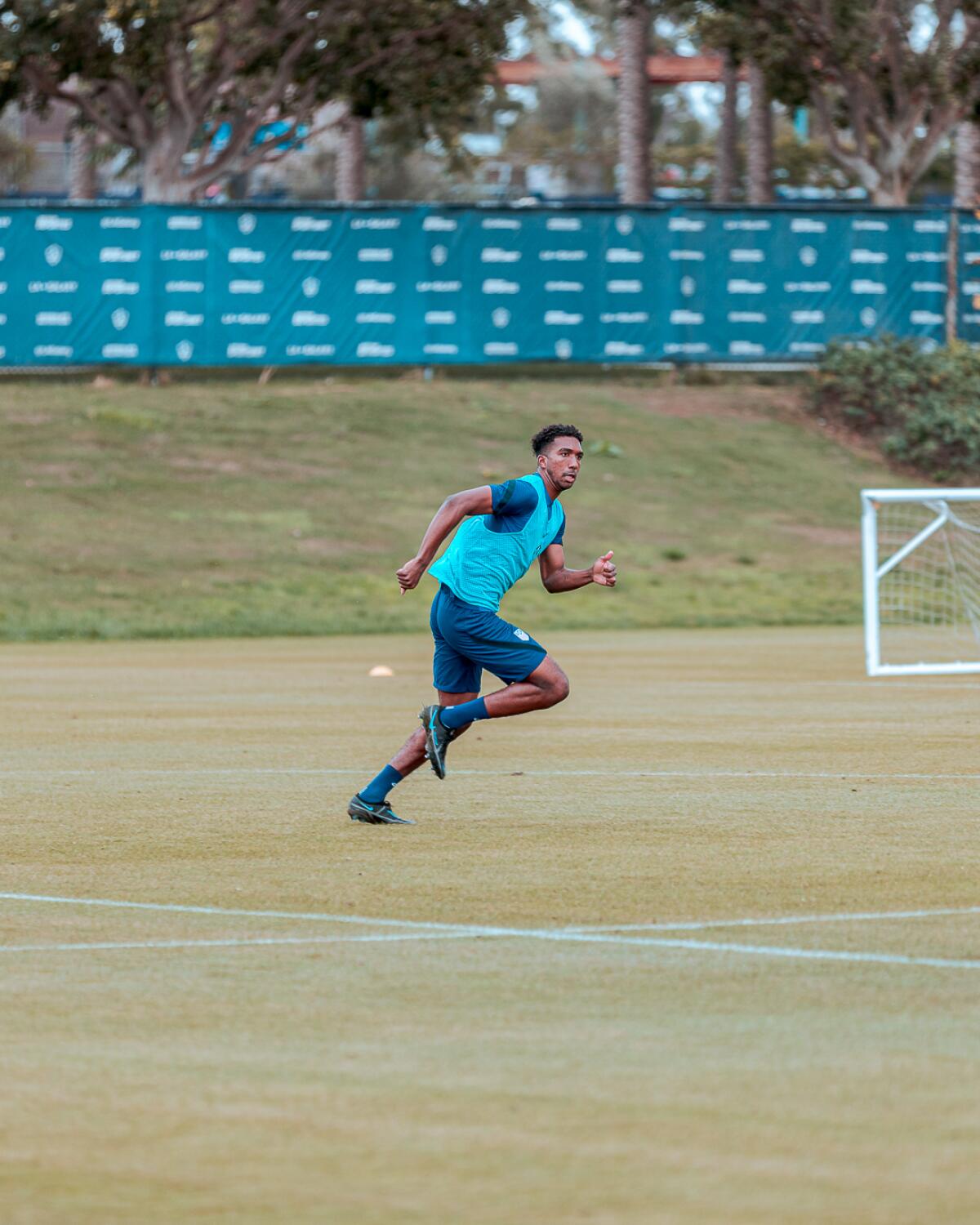
You can call Kobi Henry impatient. Or maybe confident.
But you also have to call the former Orange County Soccer Club defender prescient after he jumped from the second tier of U.S. soccer to French club Reims, which paid a USL-record $700,000 transfer fee to sign Henry to a five-year contract.
Henry was a Florida high schooler when he enrolled in the youth program at Orlando City, but he stayed just a year before joining Inter Miami, Florida’s other MLS club. Neither gave him the opportunity he wanted, so at 16, Henry stepped down to the second-tier USL Championship with Orange County.
It was a decision that could mean millions to Henry and the club.
“A big factor in this was Orange County providing me with a platform to grow and develop with hopes of getting over to Europe,” said Henry, who appeared in 18 games last year in helping Orange County to the USL championship. “They gave me the opportunity to play and prove myself and develop and showcase my talent. I’m grateful.
“For me, this pathway worked perfectly.”
Henry had to have talent to showcase to make it work, and he had enough to merit a call-up to the senior national team last December at age 17. He also impressed Reims, which paid the largest transfer fee in USL Championship history for his rights.
The French team has a reputation for buying players, developing them and selling them for a profit, something that would benefit OCSC, which will get at least 15% of the next transfer fee.
“I always knew I wanted to go to Europe and play at the highest level,” Henry said. “So I was really dedicated and motivated to reach my goals.”
This is just the first step. The soccer world is littered with players who were prospects at 18 but saw their progress stalled by 21. Henry is aware of that and determined to keep it from happening to him.
“It’s so important to continue to work and to never be satisfied. That’s definitely the mindset that I have,” he said.
And finally there’s this …
CONCACAF Nations League play is done for this year and the U.S., the reigning champion, and Mexico went out with a whimper. The Americans, playing on a horrific, muddy pitch in El Salvador, needed a stoppage-time goal from Jordan Morris to escape with a 1-1 draw while Luis Romo’s goal in first-half stoppage time gave El Tri a 1-1 tie in Jamaica. Both teams will end the year second in their respective three-team groups. Neither team will play another competitive match before opening the World Cup in Qatar in November.
In case you missed it
How Alex Morgan, Liz Cambage and Ali Krieger are solving a problem facing women in sports
SoFi Stadium in Inglewood among venues selected to host 2026 World Cup matches
Podcast
Don’t miss my weekly podcast on the Corner of the Galaxy site as co-host Josh Guesman and I discuss the Galaxy each Monday. You can listen to the most recent podcast here.
Quotebook
“I’ve learned that when she’s happy and healthy, she’s in a good spot and she performs well. I just want to keep her there. This is all credit to Alex. She’s come in and applied herself, she’s been open-minded, she’s really coachable, she gives what she needs to give to the team and encourages everybody else to do the same.”
Coach Casey Stoney on San Diego Wave forward Alex Morgan, whose two goals in Sunday’s 3-0 win over Gotham FC gave her a career-best 11 scores in 10 games
Until next time...
Stay tuned for future newsletters. Subscribe here, and I’ll come right to your inbox. Something else you’d like to see? Email me. Or follow me on Twitter: @kbaxter11.
Go beyond the scoreboard
Get the latest on L.A.'s teams in the daily Sports Report newsletter.
You may occasionally receive promotional content from the Los Angeles Times.




